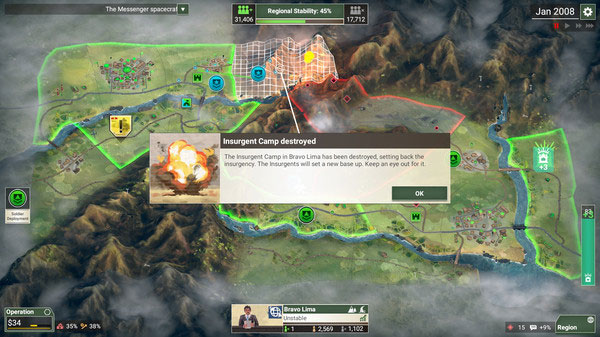

One big aspect of ‘defeating’ the insurgents is making peace with them. So the conflict with them is drawn out and we need to keep them suppressed long enough till the region is stabilised. If we beat one group, another one will appear somewhere else, or they will simply escape to another zone. Having a soldier troop isolated from the other troops makes them inefficient and unlikely to beat the insurgents in the region, unless they’re strengthened by a garrison. We can only have one group of soldiers per region, but how we place them is important, because in order to maximize their fighting capability, we have to put other soldier troops in neighbouring regions so that they have a synergy. There is a wealth of different military options available: 1) the coalition soldiers, who can be deployed quickly and are good in combat, but whose tour of duty only lasts a few in-game years 2) national soldiers, who are slower to deploy and are slightly weaker, but whom we can have permanently 3) airstrikes, which bombard insurgent camps and enforcements with good efficacy but also run the risk of civilian casualties 4) drones, which are needed to quickly detect insurgent ambushes and camps, 5) garrisons, which provide additional combat strength to the soldiers that are stationed in that region. The more regions we control versus the regions controlled by the insurgents, the better our reputation will be and the more funding we’ll get. It then becomes a battle for the regions. Soon after we begin the scenario, insurgents start to appear at different parts of the map, attempting to steer the populace against us and make us lose reputation. The military programmes help us to deal with the insurgent threat.

If corruption gets too high, we’ll start losing our global reputation. Government ones give us various bonuses and help to tackle some problems, such as the rising corruption for example. In addition to the support programmes, there are also government programmes and military ones. It’s more beneficial of course to prioritise the roll out of the programmes that the regions need the most, but some other programmes also play crucial roles and can help us greatly.

However, we can choose in what order we roll them out, as we go along them akin to ‘skill trees’. Our job is to roll out support programmes to every region on the map. They also have their own needs that pop up from time to time. Regions have their own characteristics – for example being urban, rural, or remote (in the mountains). Once we begin a scenario, we have a map view broken down into different regions. There are also three difficulty modes to choose from. Each governor and advisors have their own perks that can help to steer the strategy in one direction or another. When choosing to play a scenario, we can choose the type of governor we’ll play as, as well as any advisors. We can play each map as a standalone scenario, we can play them all as a campaign, and we can also undertake weekly challenges where certain rules and conditions are introduced. There are several different maps and game modes present.


 0 kommentar(er)
0 kommentar(er)
